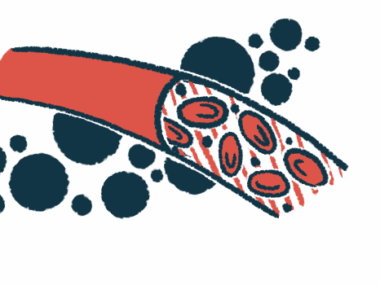Novel procedure used to repair aneurysm in teen with vEDS
UK team used unique minimally invasive technique to prevent rupture risk
Written by |

A novel minimally invasive surgical procedure called percutaneous transhepatic coil embolization was successfully used to treat an aneurysm in a 17-year-old boy with vascular Ehlers–Danlos syndrome (vEDS), a new study reports.
“This case highlights the importance of an integrative multidisciplinary approach in managing complex vascular emergencies and successfully demonstrates how a direct percutaneous transhepatic approach can serve as a valuable reference for similar cases, expanding the repertoire of … techniques for challenging [conditions],” the researchers wrote.
The case report, “Percutaneous transhepatic coil embolisation of a common hepatic artery aneurysm in vascular Ehlers–Danlos syndrome,” was published in CVIR Endovascular.
Understanding vascular Ehlers–Danlos syndrome
vEDS is characterized by extremely fragile blood vessels that are prone to tearing. This can cause aneurysms — when part of a blood vessel becomes weakened and starts to bulge out, filling with blood and expanding like a water balloon inflating.
Treating aneurysms in people with vEDS can be especially complex. Clinicians must find ways to prevent a rupture while avoiding additional trauma to the already-fragile blood vessels.
Here, a team of scientists in the U.K. described the case of a 17-year-old boy with a known diagnosis of vEDS who sought medical care due to sudden abdominal pain that spread to his groin. Initial tests indicated the boy had a tear in the final portion of the bowel.
The boy underwent surgery to repair the tear, which was completed without incident. However, he returned to the hospital soon after — reporting newfound pain in the upper right abdomen, where the liver is located.
A CT scan showed an aneurysm in a large liver blood vessel, and a dilation on another liver blood vessel — “escalating the situation to a vascular emergency due to imminent risk of rupture,” the researchers wrote.
A complex decision on how to proceed
Doctors then faced a difficult decision. Aneurysms are often managed using endovascular coiling — a minimally invasive procedure where a thin tube is guided to the aneurysm to deliver flexible coils that will block blood flow.
This basically seals off the damaged part of the blood vessel and prevents any more blood from getting in, which could increase pressure and cause the aneurysm to burst.
But this technique usually involves threading the tube and coils through blood vessels, and in this patient, the blood vessels were narrow and fragile enough that clinicians were worried about doing excessive damage on the way in.
Another option was a liver transplant. However, this would have been extremely invasive, not to mention the logistical complications of finding a donor.
Instead, the clinicians opted for percutaneous transhepatic coil embolization, a minimally invasive procedure that involves inserting a needle through the skin and liver to access a blood vessel and deliver the flexible coils to block blood flow. The procedure is guided through ultrasound scans.
“This had the advantage of bypassing complex vasculature but carried significant risks such as damage to surrounding structures and catastrophic internal bleeding,” the researchers wrote.
This was considered a high-risk procedure, and the clinicians held frank discussions with the boy and his family before proceeding. The clinicians also took careful precautions, such as having a battery of different options to control bleeding on hand during the surgery.
Successful outcome and follow-up
The procedure was ultimately successful at managing both the aneurysm and the dilated liver blood vessel. Follow-up imaging showed the aneurysm was no longer filling with blood, and the boy’s liver was still getting a steady supply of blood needed to be healthy.
The boy recovered without complications and was discharged nine days after surgery.
“The severity of the gut perforation and vascular instability observed in this case aligns with the patient’s underlying vEDS,” the researchers wrote.
While it’s possible this aneurysm developed as a complication of the intestinal tear or the surgery, this is unlikely given the distance between the liver and the part of the intestine that was affected, the team noted.
The researchers believe it is more likely the aneurysm occurred spontaneously, and the timing just happened to coincide with the intestinal tear and surgery.
Overall, this case highlights that this type of minimally invasive surgery may be feasible to manage aneurysms in some vEDS patients, though the researchers stressed careful consideration is necessary.
“While this approach proved successful, it is important to acknowledge that direct transhepatic aneurysm coiling may not be feasible in all centres,” the scientists wrote, adding this type of procedure “is operator dependent, carries significant inherent risks, and requires multidisciplinary planning and a high level of expertise in interventional radiology.”






